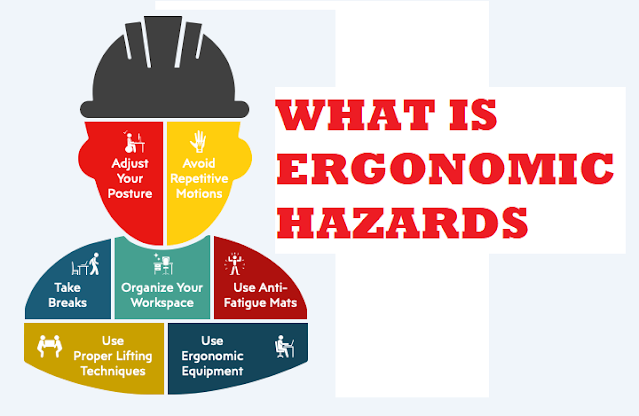What is Ergonomic Hazards – Know about It
What is Ergonomic Hazards – Know about It.
Ergonomic injuries are mainly termed in the following
categories, example:
Cumulative trauma disorders (CTDs). Ergonomic injuries
involve strain that may develop, or accumulate, over time.
Repetitive strain injuries (RSIs). Ergonomic injuries are
often caused by repeating the same motions over and over.
Musculoskeletal disorders (MSDs). Ergonomic injuries affect
the muscles, bones, tendons, nerves, and tissues.
These disorders include a number of specific diseases such
as carpal tunnel syndrome, bursitis, and tendinitis. Back injuries are the most
common and most costly MSD.
Symptoms of these disorders are most common in the back, hands, arms, wrists, elbows, neck, and shoulders. They include:
• Soreness or pain (aching or sharp)
• Stiffness
• Swelling
• Loss of coordination
• Numbness
• Tingling (as though the area is “asleep”)
• Unexplained weakness
Risk Factors for Ergonomic Injuries
The field of ergonomics examines the fit between employees
and their jobs. Ergonomics looks at:
• What body movements and positions people use when they
work
• What tools and equipment they use
• The physical environment (temperature, noise, lighting,
etc.)
• The organizational environment (deadlines, teamwork,
supervision)
• Whether any of these factors may place an employee at risk
of injuries or illnesses
The goal of ergonomics is to fit workplace conditions and
job demands to the capabilities of the individual worker, instead of making the
worker fit the job.
To prevent injuries, ergonomic risk factors must be
identified. Ergonomic risk factors are workplace
situations that cause wear and tear on the body and can cause injury. Once these have been identified, you can work on finding ways to eliminate them.
If You Believe You Have an MSD
• Seek early treatment. The longer you have symptoms without getting help, the harder they can be to treat successfully.
• Find a doctor who understands work-related health problems. Don’t be afraid to educate your doctor about the possible causes of your MSD.
• If your problem is work-related, report it to your supervisor. You may be eligible to file a workers’ compensation claim to cover lost work time and/or medical costs.
Safety Management Systems for HSE Professionals
• It is best not to return to the same working conditions that caused your problem. Work with others at your workplace to ensure that the equipment or activities that contributed to your injury are changed.
• Finding the right doctor, getting effective treatment, and improving your work environment take persistence and energy. Don’t hesitate to ask for help and don’t give up until the problem is solved.





No comments:
Post a Comment